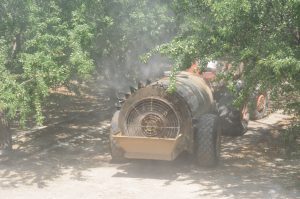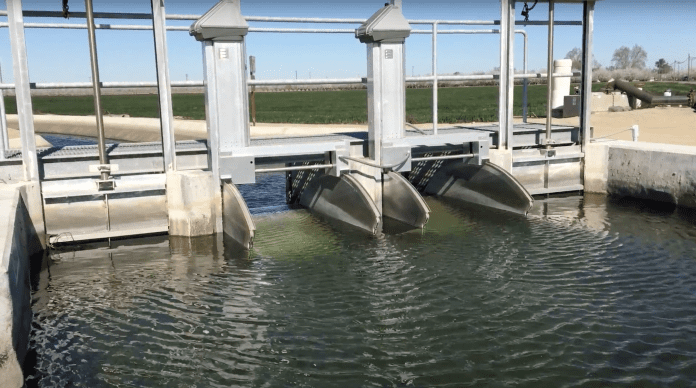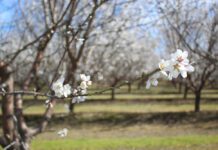Determining water and labor availability, weighing input costs against market prices and making plans for orchard sites are all vital parts of making both one-year and multi-year plans for tree nut orchards.
Plans may have to have some built-in flexibility, but they are also a way of charting a course through potentially tough financial and agronomic times.
“Every year offers surprises,” noted UC Davis agricultural economist Dan Sumner.
“When cost of production is higher than price, you have to figure out where to cut costs, but be sure long-term health of your trees is not affected,” Bill Carriere, Glenn County walnut grower and processor, said.
Sumner said that recognizing new issues will arise in 2023, and every forecast is subject to change.
There is no doubt that water availability in 2023 is foremost in most every grower’s mind. Precipitation during the coming water season is fundamental, Sumner said. A great water year will allow some space for gradual adjustments; another poor water year will leave all of California agriculture in desperate straits.

Plan for the Worst, Hope for the Best
“Plan for the worst, but hope for the best,” said UCCE Farm Advisor Franz Neiderholzer.
Growers looking for long-range guidance on water availability can look at the National Weather Service Climate Prediction model, he said, but should still plan for a range of scenarios going forward. The Sustainable Groundwater Management Act is not going away, Sumner said, nor are environmental demands for water. Agriculture, including tree nuts, will continue to make do with less.
Inflation means higher input prices for tree nut crops. Sumner said higher prices plus higher labor costs will challenge margins in the coming season. High interest rates mean that generating net returns to planting nut crops, with very long horizons before full production is achieved, is even more challenging.
Sumner added that no one can reliably predict exchange movements, but exports cannot benefit from high value of the dollar, which means foreign customers are paying a higher price in terms of yen, won, pounds or Euros, even when exporters or growers here receive only moderate prices in U.S. dollar terms. He said this adds one more burden to generating higher prices in dollar terms. A U.S. (and global) recession may be on the horizon given the government’s response to inflation and would add to the burden, Sumner concluded.
Taking a hard look at the ground is also necessary when planning for 2023. Neiderholzer noted in Sacramento Valley Walnut News that plans are important, but they should also be flexible.
For growers with multiple blocks of orchards, a hard assessment of individual costs, yields, age of orchard, variety and rootstock helps with forming an overall management plan.
Carriere said the biggest thing in his operations’ plan for next year is looking at the historical yield of orchards and assessing what worked this year. If, given the age and variety of the block, plus the market, there is no improvement in production, a decision has to be made to pull.
As an example, he said they are taking a hard look at Hartley orchards as the market is shrinking and the trees are relatively old. These are in a phase-out plan, he said.
Carriere said they start long-term planning following harvest, weighing the expense of pulling an orchard plus not realizing an income from the ground in the short term. It is important to analyze the varieties and their markets, looking at both short- and long-term prospects.
“Do we milk it one more year or replace it?” he asked.
He said planning is done for the coming year as well as three to five years ahead. In the meantime, they may be executing plans made 10 to 15 years ago. Plans may be tentative, he said, but they are plans.
Make Tough Decisions to Manage Input Costs
Wilbur Ellis Technical Nutrition Agronomist Matt Comrey said managing input costs will require some tough decisions by growers. Starting with dry inputs, he said to look carefully at soil nutrition levels and tissue samples. Consult with your crop consultant, he said, and discuss what is necessary to maintain crop health and what might be skipped.
This also might be a year where leaching orchard soils during dormancy can be helpful, Comrey added.
“This might be a time to ‘lean on’ consultants, work on historical orchard inputs and trends and come up with a plan.”
When it comes to land use and options for orchards, Comrey said production levels, what kind of water district you are in and financing will drive decisions on pulling and redeveloping an orchard site.
Water availability and costs will be limiting factors in pistachio production going forward, said Richard Matoian, president of American Pistachio Growers.
Location of pistachio orchard or orchard sites can determine if water will be available. Surface water delivered from the state or federal projects may or may not be an option, particularly in the amounts needed and at the cost. Purchasing water north of the Delta may not be possible due to pumping restrictions, Matoian said.
Plans for irrigation next year could also be impacted by SGMA if groundwater is the source of irrigation water.
“Groundwater agencies are already telling growers there will be limits on pumping as we go closer to full implementation of SGMA,” Matoian said. “There will be fees for pumping over the limits.”
When planning for the future, he said options include paying fees, which will depend on the economics of the commodity being produced, fallowing land or purchasing land for pumping rights.
Growers who need to make longer-term decisions may have challenges, said Almond Board of California President and CEO Richard Waycott. Many of the Central Valley almond growers are multi-generational growers and may have to look at changes in their operations depending on their water situations.
Their ability to relocate to orchard sites with more water dependability will depend on their financial capabilities and land values, Waycott said.
In their favor, tree nuts, particularly almond and pistachio, are both crops that do well agronomically in the Central Valley and have less foreign competition that many other crops.
The tipping point, Waycott said, will be cost of production and water.

Cecilia Parsons | Associate Editor
Cecilia Parsons has lived in the Central Valley community of Ducor since 1976, covering agriculture for numerous agricultural publications over the years. She has found and nurtured many wonderful and helpful contacts in the ag community, including the UCCE advisors, allowing for news coverage that focuses on the basics of food production.
She is always on the search for new ag topics that can help growers and processors in the San Joaquin Valley improve their bottom line.
In her free time, Cecilia rides her horse, Holly in ranch versatility shows and raises registered Shetland sheep which she exhibits at county and state fairs during the summer.
















